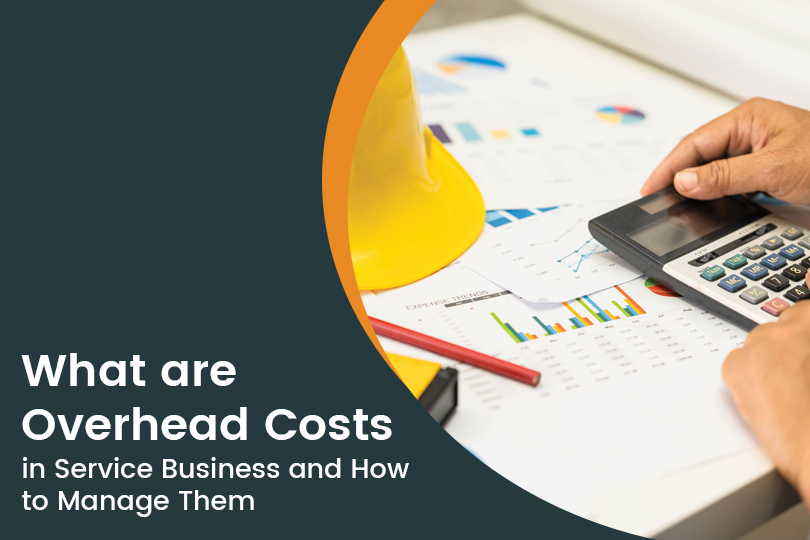What Are Overhead Costs in Service Business and How to Manage Them

The secret to making profit is simple– reduce your overhead costs.
Running a service company requires a lot of hard work. There are a thousand things that you must take care of. Among all of them, allocating costs is perhaps the most crucial task for field service business. Experts even say that your success relies on your ability to successfully allocate your costs.
Reduce your overhead costs with Field Promax. Sign Up.
Underpricing your services can drastically affect your ability to pay your overhead costs. At the same time, underestimating your potential overhead can dramatically affect your profit margins. Understandably, identifying and managing overhead costs play integral roles in your business growth. If the business owner doesn’t take care of overhead costs, it can quickly drain the business revenue. Therefore, the business owners need to take out time and figure out how to calculate the overhead cost.
To this end, first, you need to know what overhead costs are and how to calculate them. Unless you have a clear understanding, you will have a hard time managing the costs and maintaining your revenue stream. This is even more important for service businesses, for this is the fundamental principle that helps you determine the prices for your service and in turn, ensure profitability.
In case you are struggling with the task, you have stumbled upon the right place. In this blog, you will learn everything there is to know about overhead costs. Without further ado, let’s jump right into the most critical discussion that could turn your business around.
Table of Contents
What is Overhead Cost?
Overhead costs refer to ongoing business expenses but are not directly attributed to developing the products and/or services. It doesn’t include what you spend to produce goods or provide services, typically on raw materials and direct labor. These expenses are called COGS (cost of goods sold) and COS (cost of services), respectively. Simply put, anything else that you spend in your business other than COGS and COS are overhead costs.
Overhead costs will vary from business to business. However, some of the most common examples of overhead costs for service businesses are:
- Professional expenses, such as legal or accounting services
- Administrative costs
- Payroll and employee benefits
- Rent or mortgage payments
- Licenses and permits
- Insurance
- Property taxes
- Depreciation
- Inventory
- Shipping and handling
- Office equipment
- Utilities
In simple terms, overhead costs are the investment that you put in to keep your business in business. The cost is critical for a business, but it does not lead to the generation of profits.
Cut Down Your Overhead Costs with Field Promax. Book A Free Demo to Learn How.
What are the Various Types of Overhead Costs?
There are broadly three types of overhead costs that any business might incur, i.e.
1. Fixed
2. Variable
3. Semi-variable
Overhead expenses can be fixed, meaning they are the same amount every time, or variable overhead costs, which increase or decrease depending on the business’s activity level. For example, a business’s rent payment may be fixed, while shipping and mailing costs may be variable. Other fixed costs include depreciation on fixed assets, insurance premiums, and office personnel salaries.
On the other hand, overhead expenses can also be semi-variable, meaning the company incurs some portion of the expense no matter what, and the other portion depends on the level of business activity. For example, many utility costs are semi-variable with a base charge and the remainder of the charges being based on usage.

How to Allocate Overhead Costs?
To allocate overhead costs efficiently, just follow these simple steps:
- Identify Overhead Costs
- Categorize Overhead Costs
- Determine Allocation Bases
- Calculate the Allocation Rate
- Apply the Allocation Rate
- Track and Analyze
- Adjust as Needed
Begin by listing all your overhead costs. These may include rent, utilities, insurance, and the salaries of employees not directly involved in production.
Group your overhead costs into categories that make sense for your business. For example, create categories like “Facility Costs,” “Administrative Costs,” or “General Expenses.”
Allocate overhead costs using a method called an allocation base. This could be the number of products you produce, the square footage of your facility, or the number of employees. Choose an allocation base that reflects how the overhead costs are incurred.
Divide the total overhead costs in each category by the total amount of your chosen allocation base. This gives you the allocation rate, which tells you how much overhead cost is associated with each unit of your allocation base.
Multiply the allocation rate by the actual amount of the allocation base used by each product, service, or department. This gives you the allocated overhead cost for each.
Keep a record of your allocated overhead costs and regularly analyze them to ensure they accurately represent the resources each product or service consumes.
Over time, you may need to adjust your allocation methods if your business changes. For example, if you move to a larger facility, you may need to reassess how you allocate facility-related costs.
By following these steps, you can allocate overhead costs in a way that reflects the true expenses associated with producing your products or delivering your services, helping you make informed financial decisions for your business.
How to Calculate Your Overhead Costs?
To begin managing your overhead costs you need to start by identifying the critical services your company performs.
To calculate business overhead, you need first to specify your business activities and make a list of your expenses; it should be thorough. You can look through your financial statement in order to make sure that you have to pinpoint each and every cost.
Once all the business expenses are identified, sort them into two categories, namely direct and indirect expenses. Then ask yourself, does this expense impact the production of goods? Once the expenses are sorted, add all the direct and indirect expenses for the month. Now, calculate the overhead cost in the following way:
Overhead rate = Indirect costs/ Allocation measure.
The indirect costs are the overhead costs, while the allocation measure would include labor hours, or direct machine costs, which is how the company measures its production.
Here is the simple formula to calculate your overhead costs: [needs design]

How to Calculate Overhead Rate per Employee
To calculate the overhead rate per employee, follow the steps below:
- Calculate the labor cost, which includes not just the weekly or hourly pay but also health benefits, vacation pay, pension, and retirement benefits paid by the employer.
- Compute the total overheads of the business.
- Divide the overhead costs by the number of billable hours. For example, if your business has six technicians, their overhead costs are divided between them.
- Adding the overhead costs and the labor cost to billable hours gives you the net cost of that employee to the business per hour.
By lowering the proportion of overhead, a business can gain a competitive advantage by increasing the profit margin or pricing its products more competitively.
Expenses related to overhead appear on a company’s income statement, and they directly affect the overall profitability of the business. The company must account for overhead expenses to determine its net income, also referred to as the bottom line. Net income is calculated by subtracting all production-related and overhead expenses from the company’s net revenue, also referred to as the top line.

How To Manage Overhead Costs?
Here are some simple steps you can take to reduce overhead costs.
- Review monthly overhead costs: Use the steps above to calculate overhead costs each month and review them to see if there are changes you can make.
- Brainstorm with employees: Have a conversation with your employees about ideas to cut overhead costs that you may not have thought about.
- Evaluate your staff: Do you need every member of your staff to function? If there are excess positions, you can consider cutting your staff down to only the necessities.
- Re-evaluate your office space: Is your office too big for the number of employees you have? If you’re paying for unused space, consider downsizing to save on overhead costs.
- Shop around for insurance: You may be able to get a better deal on your business insurance by shopping around and comparing rates.
- Reduce energy consumption: Save on overhead costs by reducing your energy consumption. You can make a significant dent in this by using lighting controls, turning off electronics when they’re not in use, using energy-efficient LED lights, and more.
- Go paperless: If you are spending a lot on office supplies, try going paperless to save on the costs of paper, ink, staples, tape, etc.
How Does Going Paperless Help Service Businesses Reduce Overhead Costs?
According to experts, a significant portion of the overhead costs in service businesses incurs from administrative tasks. The primary job of field service is carried out in the field. However, to keep the operations running smoothly, you need to maintain an office setup and take care of a lot of trivial tasks, such as work order management, creating estimates, sending invoices, organizing customer information, and so on.
Now, if you are using traditional paper-based methods to manage your office work, you are most likely spending a huge amount in overhead costs. To be more precise, manual methods for field service delivery are neither cost-effective nor efficient. This means you must switch to automation if you want to maintain profitability.
This is where paperless business solutions come to your rescue. By going paperless, you can reduce a significant amount in terms of paper, printing, organizing, and document storage. And for a small service company, this can add up to 22% of its total overhead costs, which is a lot! Once you go digital, you are automatically cutting on this hefty expense.
How Can Paperless Service Business Software Help Manage Overhead Costs?
As evident from the discussion, going paperless could be the key to reducing your overhead costs. However, there are various tasks in a service business that requires automation in this regard.
You need a digital calendar, scheduling software, accounting software, estimate generator, billing and invoicing software, time tracker, and so many other things to keep things running smoothly. And that means more overhead costs in terms of subscription and maintenance costs.
That being said, there is an incredible alternative to all this hassle. Instead of purchasing so many software and applications, you just need to sign up for Field Promax.

Why Field Promax is the Best Choice to Reduce Overhead Costs in Your Service Business?
To keep it short, Field Promax is your one-stop solution for paperless service business software. It offers everything you need to automate and streamline your business and keep overhead costs to a minimum. The features include:
- Scheduling and Dispatching
- Estimates
- Calendar
- Reports & Analytics
- Time Tracking
- GPS
- Real-time Updates
- Alerts and Notifications
- Dynamic Team Management
- Billing and Invoicing
- Digital Signature
- Cloud Storage
- QuickBooks Integration
What’s more, Field Promax offers a dedicated mobile app for you and your field technicians. It is available for free on both Android and iOS. It runs on any handheld device, which means you don’t have to buy expensive gadgets for your employees to use it.
To sum up, calculating and managing overhead costs is crucial for the success of any service business. And there is nothing more effective than digital tools to reduce them. So, if you want to maintain profitability and generate more revenue in your business, go paperless as soon as possible. And as you can see, Field Promax is the ultimate choice for you in this regard.
There are a number of reasons to choose Field Promax. As we have discussed already, it gives you an array of digital solutions in one single platform, at a surprisingly competitive price. But that’s not all.
Field Promax is perhaps one of the most easy-to-use software out there. No need to download or install anything. No high-end technical knowledge is required. Just watch a 9-minute video and you are ready to take control of your business aided with this incredible digital tool. Not to forget, you get 24/7 customer support with any issue that might arise in future.
In short, Field Promax is the ultimate tool to reduce your overhead costs, at no extra cost at all!
For More Information, Contact us today.
Effective overhead cost management ensures that resources are allocated efficiently, contributing to better financial health and improved profitability.
Identify overhead costs by reviewing expenses not directly linked to specific products or services, including rent, insurance, and general administrative expenses.
An allocation base is a measure, like production volume or square footage, used to distribute overhead costs among products or services.
Challenges may include accurately determining the allocation base, adjusting to changes in business operations, and maintaining cost visibility.
Yes, identifying areas of inefficiency, renegotiating contracts, and adopting cost-effective technologies can help reduce overhead costs while maintaining quality.
Yes, regular reviews ensure that allocated costs remain reflective of actual resource usage, allowing for informed financial decision-making.
Efficient overhead cost management positively impacts profitability, cash flow, and the ability to invest in growth initiatives, fostering long-term business success.






